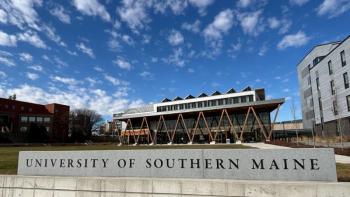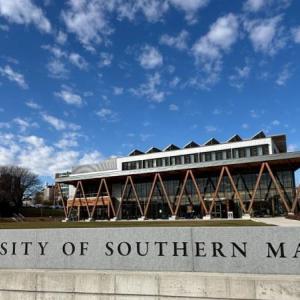Maine center guiding local opioid settlement spending says data will be public early next year
Local governments across Maine have received just over $22 million in opioid settlement funds from pharmaceutical companies accused of fueling the overdose epidemic, with nearly $54 million more expected over the next decade and a half.
The money is meant to go to prevention and harm reduction efforts, as well as treatment and recovery programs. But oversight is limited, and until recently there were no reporting requirements, meaning it was up to local officials how much they wanted to disclose about their plans.
Since the settlements began distributing the money three years ago, advocates have raised concerns about some localities’ spending choices, particularly those related to police equipment, including questionable handheld drug-checking devices.
Many municipalities and counties have struggled to determine how those choices should be made, getting caught up in the logistics of how to disburse the funds fairly, ultimately delaying much-needed help for vulnerable communities.
That’s where a $2.5 million resource center comes in: one designed to help the local governments start spending the money appropriately and maintain data on where it’s going. So far, it has created guides, grant application templates and evaluation rubrics, and assisted with more than 100 requests from local officials. The next big project is creating public data dashboards.
The Maine Opioid Settlement Support (MOSS) Center, run out of the University of Southern Maine’s Catherine Cutler Institute, was launched last summer with funding from the attorney general’s bucket of opioid settlement money.
Maine expects to receive an estimated $261 million in settlements and bankruptcy agreements with more than a dozen pharmaceutical manufacturers, distributors and retailers, including with Oxycontin-maker Purdue Pharma and the estate of their billionaire owners, the Sackler family.
Agreements signed earlier this year, like the ones finalized this month with Purdue and the Sacklers, added more than $30 million to Maine’s share, though that number may still change as the Sackler bankruptcy case is finalized. Payments will be distributed through 2038.
Maine’s share is split three ways: 50 percent to the Maine Recovery Council; 30 percent to 39 counties and municipalities, or direct share subdivisions; and 20 percent to the attorney general’s office.
The center’s goal is to help the 39 localities receiving direct payments from the settlements spend their share in an evidence-based manner and to keep communities informed about how the money is being used.
That includes creating several public dashboards, including one that will show how recipients are spending their money and another tracking the impact the spending has on local communities. The spending dashboard is expected to launch next February or March, said the center’s director, Dr. Lindsey Smith.
A law passed earlier this year means that in January the subdivisions will be required to submit their first-ever annual report on spending to the attorney general’s office. Those reports will then be shared with the MOSS Center for review and analysis, and later, with the legislature.
The center is working with the AG’s office to encourage subdivisions to submit their reports using a form created by the center, rather than on their own, in order to streamline the process and standardize the data collection.
This dashboard would mark the first statewide public disclosure of local governments’ settlement spending. Over the past two years, The Monitor has made an ongoing effort to shed light on how the millions from these landmark settlements are being spent, including by sending out detailed surveys to local officials from the 39 subdivisions.
When the settlement money was first distributed, many local governments didn’t know where to start, Attorney General Aaron Frey told The Monitor last year.
“While it’s a significant amount of money, it is limited,” Frey said. “The crisis is such that it is going to be so important that the way in which these resources are directed today, that it provides that foundation so that over the next 18 years these resources do end up addressing the harm that all of these defendants caused.”
The hope is that the MOSS Center can help.
The center is building its own tools and working directly with the subdivisions, Smith said. The early stages were focused on developing materials like a settlement funds quick guide, templates local governments can use for grant applications and rubrics to help them evaluate how particular projects would fit the approved uses.
Over the past year and a half, center staff have connected with all subdivisions except the town of York. They have provided technical and informational assistance to 27 subdivisions, according to data provided by the center, addressing questions about community-specific needs and navigating conflicts of interest during grant reviews.
In several cases, the center has worked with local governments as they established committees of public officials, addiction specialists and people in recovery to decide how the money should be spent.
This was particularly helpful in Franklin County. In the spring of 2024, commissioners had voted to dissolve the first iteration of its opioid settlement committee a year after it was formed.
As the committee prepared to review the first grant applications over two years ago, county administrator Amy Bernard told The Monitor it hoped to get money out by the end of the year. Instead, accusations of conflicts of interest, excessive red tape and personal biases mushroomed, stymying progress and ultimately leading to the group’s dissolution in April 2024.
A few months later, commissioners agreed to restart the group, this time with the MOSS Center’s involvement. The center helped the new committee develop grant applications and a scoring rubric, all of which is now available online, committee facilitator Susan Pratt said in response to a Monitor survey conducted earlier this year.
“The initial process was not as clearly delineated as the newly formatted process,” Pratt said.
Jennah Godo, the MOSS Center’s outreach and communications coordinator, said she and her colleagues are there to help fill in the gaps. “Some people have an expertise that they bring to the table … but they don’t necessarily have experience in creating a policy or doing a grant review or committee selection.”
The center is also working with Waldo County, which recently came under scrutiny for not being forthright about how county officials spent more than $100,000 in settlement funds.
Since then, the center has met with the county multiple times and attended meetings of its new ad hoc committee for opioid settlement spending, according to the center, sharing technical assistance and other resources.
Oxford County, meanwhile, formed an opioid response committee late last year and needed guidance on best practices for a grant process, deputy county administrator Abby Shanor said.
The center tailored its grant and evaluation templates for the county. MacKenzie David, the center’s community research and evaluation coordinator, regularly attends the committee’s meetings, where she’s able to answer questions about best practices and how other communities are approaching spending.
The committee’s work would be “a lot more challenging” without the MOSS Center’s assistance, Shanor said.
“It would have taken us a lot longer to process the data. We might have had a lot more questions,” she said.
The committee closed its first round of grant funding in August and made its recommendations to commissioners in September, who approved $457,000 in awards to five organizations. The money is being directed to local recovery programs and healthy community coalitions.
Eleven subdivisions have told the MOSS Center they do not need assistance at this time or are still in initial discussions about how the center can support them. In total, the center has fulfilled 123 requests for assistance, ranging from developing a grant review policy to designing a data tracking and reporting tool.
Smith, the center’s director, said their role will likely evolve over the coming years as subdivisions’ needs change. The attorney general’s contract with USM is for five years. She added that the more the MOSS Center works with local governments, the more it can share what other communities are doing.
That’s also why the center is encouraging local governments to ask grantees to track their progress and to share their outcome data for the impact dashboard.
“When we talk to communities, we say that this isn’t about putting your data on blast. It’s about being able to say this is what worked in our community, this is what didn’t work, so that somebody else isn’t starting from scratch,” Smith said. “We want to get that out there so somebody isn’t throwing good money after bad.”
This story was originally published by The Maine Monitor, a nonprofit civic news organization. To get regular coverage from The Monitor, sign up for a free Monitor newsletter here.




























